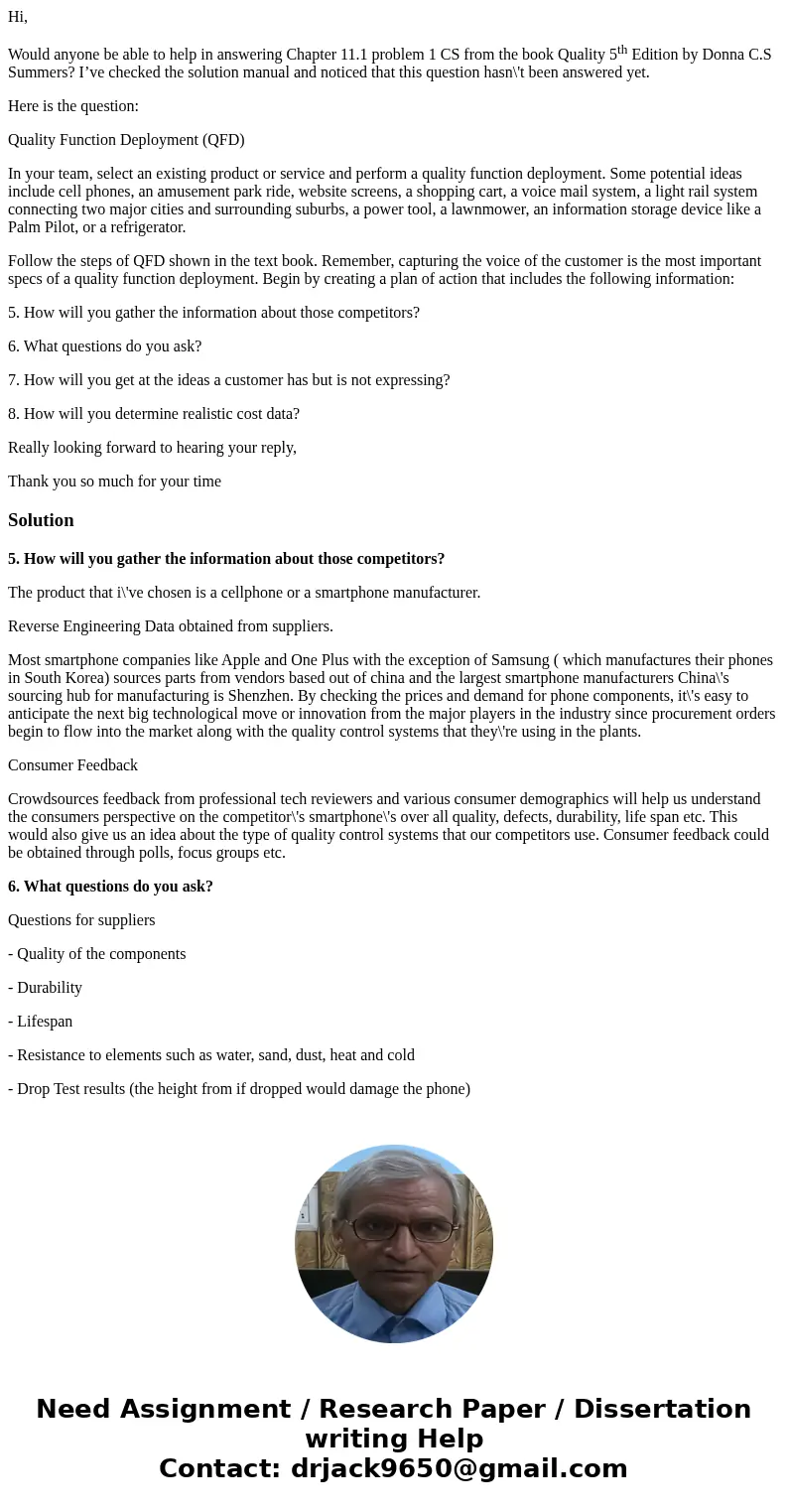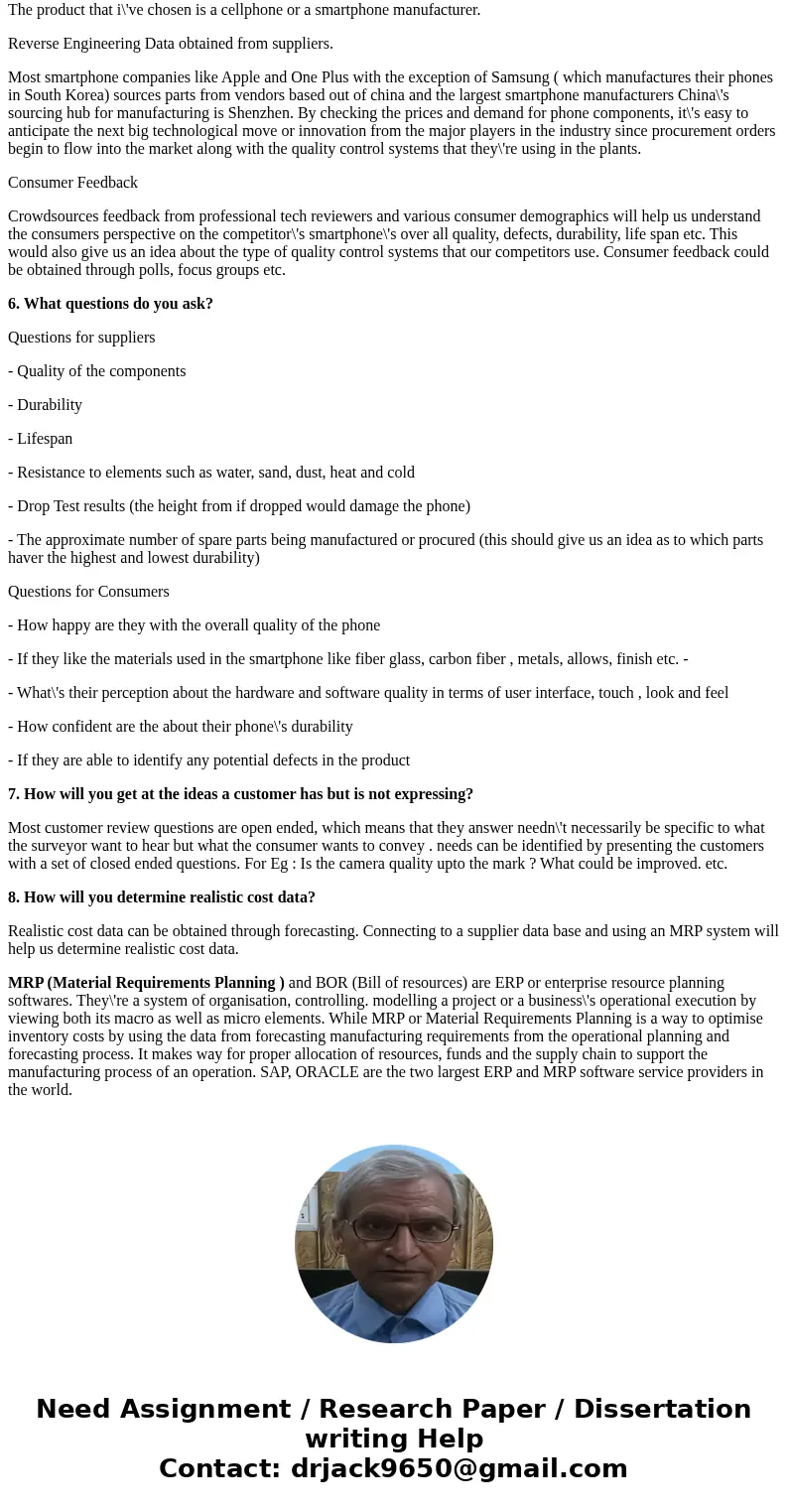Hi Would anyone be able to help in answering Chapter 111 pro
Hi,
Would anyone be able to help in answering Chapter 11.1 problem 1 CS from the book Quality 5th Edition by Donna C.S Summers? I’ve checked the solution manual and noticed that this question hasn\'t been answered yet.
Here is the question:
Quality Function Deployment (QFD)
In your team, select an existing product or service and perform a quality function deployment. Some potential ideas include cell phones, an amusement park ride, website screens, a shopping cart, a voice mail system, a light rail system connecting two major cities and surrounding suburbs, a power tool, a lawnmower, an information storage device like a Palm Pilot, or a refrigerator.
Follow the steps of QFD shown in the text book. Remember, capturing the voice of the customer is the most important specs of a quality function deployment. Begin by creating a plan of action that includes the following information:
5. How will you gather the information about those competitors?
6. What questions do you ask?
7. How will you get at the ideas a customer has but is not expressing?
8. How will you determine realistic cost data?
Really looking forward to hearing your reply,
Thank you so much for your time
Solution
5. How will you gather the information about those competitors?
The product that i\'ve chosen is a cellphone or a smartphone manufacturer.
Reverse Engineering Data obtained from suppliers.
Most smartphone companies like Apple and One Plus with the exception of Samsung ( which manufactures their phones in South Korea) sources parts from vendors based out of china and the largest smartphone manufacturers China\'s sourcing hub for manufacturing is Shenzhen. By checking the prices and demand for phone components, it\'s easy to anticipate the next big technological move or innovation from the major players in the industry since procurement orders begin to flow into the market along with the quality control systems that they\'re using in the plants.
Consumer Feedback
Crowdsources feedback from professional tech reviewers and various consumer demographics will help us understand the consumers perspective on the competitor\'s smartphone\'s over all quality, defects, durability, life span etc. This would also give us an idea about the type of quality control systems that our competitors use. Consumer feedback could be obtained through polls, focus groups etc.
6. What questions do you ask?
Questions for suppliers
- Quality of the components
- Durability
- Lifespan
- Resistance to elements such as water, sand, dust, heat and cold
- Drop Test results (the height from if dropped would damage the phone)
- The approximate number of spare parts being manufactured or procured (this should give us an idea as to which parts haver the highest and lowest durability)
Questions for Consumers
- How happy are they with the overall quality of the phone
- If they like the materials used in the smartphone like fiber glass, carbon fiber , metals, allows, finish etc. -
- What\'s their perception about the hardware and software quality in terms of user interface, touch , look and feel
- How confident are the about their phone\'s durability
- If they are able to identify any potential defects in the product
7. How will you get at the ideas a customer has but is not expressing?
Most customer review questions are open ended, which means that they answer needn\'t necessarily be specific to what the surveyor want to hear but what the consumer wants to convey . needs can be identified by presenting the customers with a set of closed ended questions. For Eg : Is the camera quality upto the mark ? What could be improved. etc.
8. How will you determine realistic cost data?
Realistic cost data can be obtained through forecasting. Connecting to a supplier data base and using an MRP system will help us determine realistic cost data.
MRP (Material Requirements Planning ) and BOR (Bill of resources) are ERP or enterprise resource planning softwares. They\'re a system of organisation, controlling. modelling a project or a business\'s operational execution by viewing both its macro as well as micro elements. While MRP or Material Requirements Planning is a way to optimise inventory costs by using the data from forecasting manufacturing requirements from the operational planning and forecasting process. It makes way for proper allocation of resources, funds and the supply chain to support the manufacturing process of an operation. SAP, ORACLE are the two largest ERP and MRP software service providers in the world.


 Homework Sourse
Homework Sourse